
The canyon towhee is a bird of the family Passerellidae. Until 1989, the Canyon Towhee and the California towhee were considered to be a single species which was called the Brown Towhee.

The crimson-collared tanager is a rather small Middle American songbird. It was first described by the French naturalist René-Primevère Lesson in 1831, its specific epithet from the Latin adjective sanguinolentus, "bloodied", referring to its red plumage.
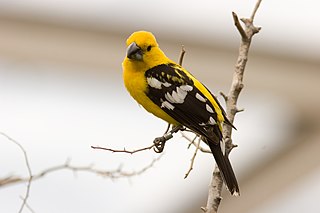
The yellow grosbeak, also known as the Mexican yellow grosbeak, is a medium-sized seed-eating bird in the same family as the northern cardinal, "tropical" or "New World" buntings, and "cardinal-grosbeaks" or New World grosbeaks.

The crimson-collared grosbeak is a medium-size seed- and leaf-eating bird in the same family as the northern cardinal, Cardinalidae.

The hooded grosbeak is a passerine bird in the finch family found in the highlands of Central America, principally in Mexico and Guatemala.

The mistletoe tyrannulet is a very small bird, a passerine in family Tyrannidae, the tyrant flycatchers.

The American gray flycatcher, American grey flycatcher, or just gray flycatcher as it is known in North America, is a small, insectivorous passerine in the tyrant flycatcher family. It is common in the arid regions of western North America, especially the Great Basin. From sagebrush steppes to pinyon-juniper woodlands and ponderosa pine forests, this flycatcher forages for insects from shrubs or low tree branches.

The solitary eagle or montane solitary eagle is a large Neotropical eagle. It is also known as the black solitary eagle.

The elegant quail is a species of New World quail endemic to Pacific-slope thorn forest of north-western Mexico, from southern Sonora to Nayarit. These are common, mainly ground-dwelling birds, and the IUCN has rated them as being a "species of least concern".

The Yucatan wren is a species of bird in the family Troglodytidae. It is endemic to Mexico. Its natural habitat is subtropical or tropical dry shrubland, only found on the narrow coastal strip of the northern Yucatán Peninsula. One of the critical habitats of this species is the Petenes mangroves ecoregion of the Yucatan coast. It is threatened by habitat destruction.

The russet nightingale-thrush is a species of bird in the family Turdidae. It is endemic to Mexico.

The white-throated jay, also known as the Omiltemi jay, is a species of bird in the family Corvidae. It is endemic to the Sierra Madre del Sur ranges of Mexico.
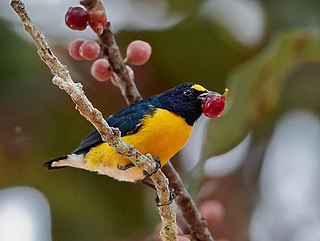
The white-vented euphonia is a species of bird in the family Fringillidae.
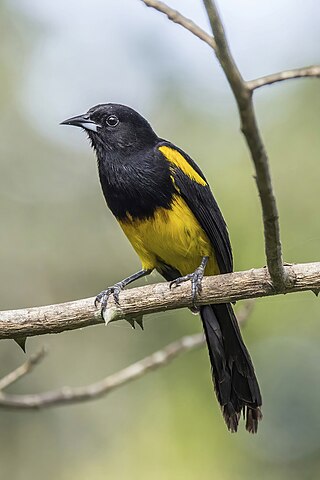
The black-cowled oriole is a species of bird in the family Icteridae. It is common and widespread in the Caribbean lowlands and foothills from southern Mexico to western Panama. It lives primarily in humid or semihumid forest, as well as in clearings, along forest edges, in plantations, in semi-open areas with scattered trees and bushes, and in gardens. The adult male is black, with yellow on the belly, shoulder, rump, wing lining, and crissum. The female's plumage varies depending on location. In the south of its range, it is similar to that of the male. In the north, its crown and upperparts are olive-yellow, while its face, throat, upper breast, wings, and tail are black.

The blue mockingbird is a species of bird in the family Mimidae. It is endemic to Mexico, but has occurred as a vagrant in the southern United States. Its natural habitats are subtropical or tropical dry forests, subtropical or tropical moist montane forests, and heavily degraded former forest.

The rusty-crowned ground sparrow is a species of bird in the family Passerellidae that is endemic to western and southwestern Mexico. The species occurs both in the Sierra Madre Occidental range, and the Cordillera Neovolcanica mountain belt.

The Veracruz moist forests is a tropical moist broadleaf forests ecoregion in eastern Mexico.
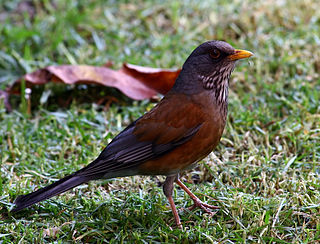
The rufous-backed robin is a songbird of the thrush family. It is endemic to the Pacific slope of Mexico. It is also known as the rufous-backed thrush.

A Guide to the Birds of Mexico and Northern Central America is a field guide to birds, covering 1070 species found in Mexico and five other countries in northern Central America. It is a 1995 book by Steve N. G. Howell and Sophie Webb, published by Oxford University Press.
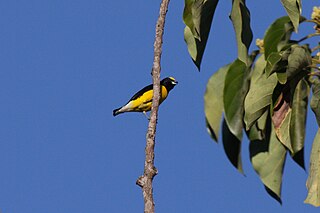
The West Mexican euphonia is a species of bird in the family Fringillidae. It was split from the scrub euphonia in 2021.























